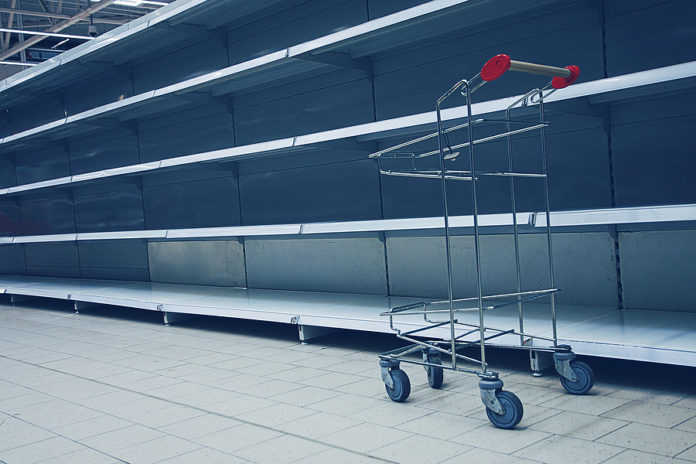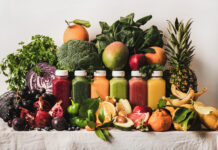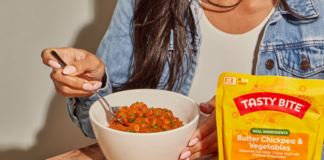
By Ali Hasan R., co-founder and CEO of ThroughPut Inc.
Toilet paper shortages received a tremendous amount of media attention at the onset of the pandemic, but customers were far more concerned by shelves empty of meat, milk, flour, and other staple food items. Anxious about low inventories and noticing the limitations many grocery chains were imposing on certain items, consumers often responded by buying the maximum amounts — even when they didn’t necessarily need the products right away.
Panic-buying made a precarious situation even worse, and online ordering further complicated matters for the food and beverage industry. Shoppers sometimes had to wait days for open delivery slots at their local grocers. And when the delivery date arrived, just a fraction of the requested items would be included.
For consumers used to well-stocked shelves and instant access to their favorite items, it’s hard to imagine how this could happen in the year 2020. For leaders in the food and beverage industry, on the other hand, it’s easy to see how quickly a supply chain can break down.
Challenges in end-to-end distribution
The sheer quantity of choices consumers have at the grocery store is one of the first big problems with food and beverage supply chains. With such a vast number of products and variety at the retail level, there’s nearly an infinite number of fulfillment scenarios for operations to manage.
The further away from the consumer end you are, the more likely you are to overshoot or undershoot both production and fulfillment needs. The further away from the output end you are, the more likely you are to either over-order or under-order, creating a glut or a shortage. In the middle of the value chain, you are essentially firefighting to manage expectations on both sides of the equation.
If there is enough lead time and buffer stock to fulfill demand, the problem often goes unnoticed. Unfortunately, when consumers’ panic-buying quickly consumes that small amount of buffer inventory, the fallacies of globally distributed supply chains are exposed. In most cases, critics point to just-in-time fulfillment, but it’s merely a scapegoat. The problem isn’t with just-in-time, but rather with poor management of sales and operations in real-time environments.
The shorter the response time gets between the consumer demand and source of supply, the more likely the planning systems are to be overridden, with new orders placed as quickly as possible to meet the spike in demand.
Why tracing goods isn’t enough
Putting a lightbulb on a product doesn’t make it move faster, but it makes it visible. If a lack of visibility was the root cause of the delay in production, tracing can eliminate it and reestablish flow. If it wasn’t, however, the product was very likely a waste of money.
Tracing goods might prevent slippage and reduce loss, but it has major limitations. In many cases, it will only highlight with pinpoint accuracy how inherently sluggish and poorly designed some supply chains still are by enabling companies to watch their products move through these environments at a snail’s pace.
Tracers make sense where yield loss is the concern, but when the primary objective is increasing speed or throughput, you need systems in place that make products move faster. These systems might accomplish this goal by reestablishing constant flow, clearing out obstacles (such as products) that create bottlenecks or constraints, or by assessing what products are actually needed and reorienting production to fulfill these needs.
By improving speed and throughput, food and beverage manufacturers can increase profits by meeting rapidly evolving consumer demands at a moment’s notice. Here are the two main ways to eliminate bottlenecks and move products faster:
1. Replan production schedules at a global level
Most companies don’t realize that they already have the capacity necessary to make more products in fewer hours — they just need to make the goods at the places that get the job done the quickest. This lean manufacturing concept from Toyota, designed to minimize waste and maximize value, can be scaled to a global level.
By reducing huge inventory stockpiles of both raw materials and finished goods that slow down production and create “walls” that lead to higher turnover, organizations can free up the resources to make products that fly off the shelves. By leveraging historical data, food and beverage companies can identify their untapped capacity and take advantage of it on a global schedule.
2. Simplify your product mix
A wider range of product offerings allows food and beverage manufacturers to capture new markets, but there are plenty of instances where the juice isn’t worth the squeeze. Sometimes, a percentage of a product line isn’t being bought in time, which raises the question of why it’s being produced in the first place.
Leveraging real-time and historical demand data helps companies eliminate certain products that aren’t worth selling, freeing up valuable manufacturing, warehousing, and trucking resources. By reducing constraints on what’s actually selling, companies can then maximize production output of their most profitable products, resulting in a positive feedback loop that makes for better sales and operations-planning practices.
Supply chains in the food and beverage industry are incredibly complex, and they are made more so by the limited shelf life of many items. Unless a dairy company wants to know exactly where milk is when it goes bad, however, tracing isn’t the answer. Instead, organizations must strive to improve the speed of products through the supply chain, which means breaking apart bottlenecks and responding to demand in real time.
 Ali Hasan R. is the co-founder and CEO of ThroughPut Inc., the artificial intelligence supply chain pioneer that enables companies to detect, prioritize, and alleviate dynamic operational bottlenecks. Ali’s unique experiences in onshore and offshore supply chain management in the United States, Russia, United Arab Emirates, Saudi Arabia, Pakistan, Bahrain, and Yemen have produced results for customers’ ongoing work, which is now featured at some of the world’s most recognized brands.
Ali Hasan R. is the co-founder and CEO of ThroughPut Inc., the artificial intelligence supply chain pioneer that enables companies to detect, prioritize, and alleviate dynamic operational bottlenecks. Ali’s unique experiences in onshore and offshore supply chain management in the United States, Russia, United Arab Emirates, Saudi Arabia, Pakistan, Bahrain, and Yemen have produced results for customers’ ongoing work, which is now featured at some of the world’s most recognized brands.









